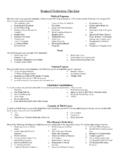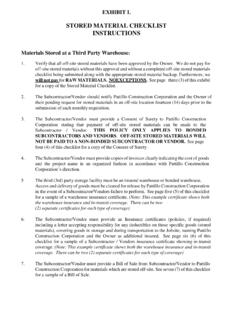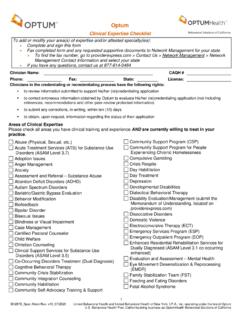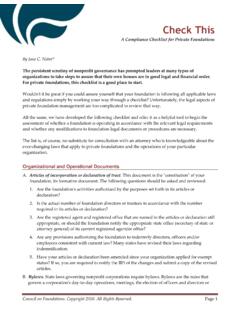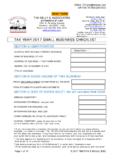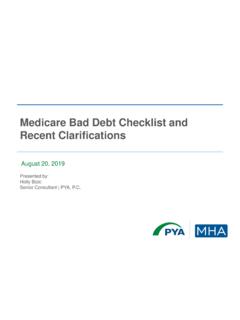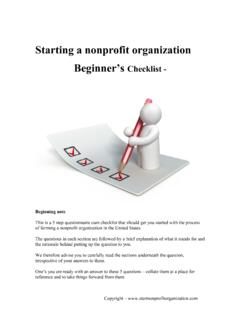Transcription of Sample Athletic Emergency Action Plan
1 Gifts to support The Korey Stringer Institute may be made through the UConn Foundation, Inc. a tax-exempt 501(c)(3) corporation dedicated exclusively to benefit the University, and are deductible for federal incomes tax purposes to the extent allowable by law. All gifts will be used to benefit The Korey Stringer Institute and its mission. Sample Athletic Emergency Action Plan The following Sample Emergency Action plan is just an example. Relevant changes should be made based on each institution s staffing availability, athlete age group, and site location. Depending on the setting, the institution may not have an Athletic trainer present at all times. You should make relevant notes and plans throughout the EAP to ensure that proper protocol can be followed no matter who is available. Also, you should take state and federal laws and policies into consideration when developing your own Emergency Action plan, when planning for heat illnesses or concussions.
2 Table of Contents 2 Overview of Emergency Action Plans (EAPs) - Introduction - Components of an EAP - Emergency Personnel - Emergency Communication - Emergency Equipment - Medical Transportation - Non-medical Transportation 6 Emergency Contact List 7 Accident/Injury Contact Phone Tree 8 Sample Campus Map 9 Campus Map with AED Locations Marked 10 Venue Information Chart 11 Sample EAP for a given venue (an EAP should be done for each sport at each venue that they may practice or host competitions) 12 Staff Medical Certification Requirements 13 Verification of Training Using the Emergency Action Plan Gifts to support The Korey Stringer Institute may be made through the UConn Foundation, Inc. a tax-exempt 501(c)(3) corporation dedicated exclusively to benefit the University, and are deductible for federal incomes tax purposes to the extent allowable by law.
3 All gifts will be used to benefit The Korey Stringer Institute and its mission. NAME OF SCHOOL Emergency Action PLAN FOR ATHLETICS OVERVIEW Introduction Emergency situations may arise at any time during Athletic events. Expedient Action must be taken in order to provide the best possible care to the sport participant. The development and implementation of an Emergency Action plan will help ensure that the best care will be provided. As emergencies may occur at any time and during any activity, all school activities workers must be prepared. Athletic organizations have a duty to develop an Emergency plan that may be implemented immediately when necessary and provide appropriate standards of Emergency care to all sports participants. As Athletic injuries may occur at any time and during any activity, the sports medicine team must be prepared.
4 This preparation involves formulation of an Emergency plan, proper coverage of events, maintenance of appropriate Emergency equipment and supplies, utilization of appropriate Emergency medical personnel, and continuing education in the area of Emergency medicine and planning. Hopefully, through careful pre-participation physical screenings, adequate medical coverage, safe practice and training techniques and other safety avenues, some potential emergencies may be averted. However, accidents and injuries are inherent with sports participation, and proper preparation on the part of the sports medicine team should enable each Emergency situation to be managed appropriately. Components of an Emergency Plan 1. Emergency Personnel 2. Emergency Communication 3. Emergency Equipment 4. Roles of First Responder 5. Venue Directions with a Map 6.
5 Emergency Action Plan checklist for Non-Medical Emergencies Gifts to support The Korey Stringer Institute may be made through the UConn Foundation, Inc. a tax-exempt 501(c)(3) corporation dedicated exclusively to benefit the University, and are deductible for federal incomes tax purposes to the extent allowable by law. All gifts will be used to benefit The Korey Stringer Institute and its mission. Emergency Personnel The first responder in an Emergency situation during an Athletic practice or competition is typically a member of the sports medicine staff, such as a certified Athletic trainer. However, the first responder may also be a coach or another member of the school personnel. Certification in cardiopulmonary resuscitation (CPR), first aid, automated external defibrillator (AED), prevention of disease transmission, and Emergency plan review is required for all athletics personnel associated with practices, competitions, skills instructions, and strength and conditioning [also including: Athletic director, school nurse, certified Athletic trainer, all coaches, etc.]
6 ]. Copies of training certificates and/or cards are maintained in the Athletic training facility and/or with the Athletic director. The Emergency team may consist of physicians, Emergency medical technicians, certified Athletic trainers, Athletic training student, coaches, managers, and possibly bystanders. Roles of these individuals will vary depending on different factors such as team size, Athletic venue, preference of the head Athletic trainer, etc. The four basic roles within the Emergency team are: 1. Establish scene safety and immediate care of the athlete: This should be provided by the most qualified individual on the medical team. 2. Activation of Emergency Medical Services: This may be necessary in situations where Emergency transportation is not already present at the sporting event.
7 Time is the most critical factor and this may be done by anyone on the team. However, the person chosen should be someone who is calm under pressure, communicates well, and is familiar with the location and address of the sporting event. 3. Equipment Retrieval: May be done by anyone on the Emergency team who is familiar with the types and locations of the specific equipment needed. Athletic training students, managers, and coaches may be good choices for this role. 4. Direction of EMS to the Scene: One of the members of the team should be in charge of meeting the Emergency medical personnel as they arrive at the site.
8 This person should have keys to locked gates or doors. Formation of an Emergency team and implementation of specific roles are important. You should also assign more than one person to a role in case certain members are not present during a given situation. Gifts to support The Korey Stringer Institute may be made through the UConn Foundation, Inc. a tax-exempt 501(c)(3) corporation dedicated exclusively to benefit the University, and are deductible for federal incomes tax purposes to the extent allowable by law. All gifts will be used to benefit The Korey Stringer Institute and its mission. Activating Emergency Medical Services Call 9- 1- 1 Provide Information - name, address, telephone number of the caller - nature of Emergency (medical or non- medical*) - number of athletes - condition of athlete(s) - first aid treatment initiated by the first responder - specific directions as needed to locate the Emergency scene ( use the south entrance to the stadium on Pomfret Street)
9 - other information requested by the dispatcher *If non- medical, refer to the specified checklist of the school s non- athletics Emergency Action plan Emergency Communication Communication is a key to a quick, efficient Emergency response. There should be a pre-established phone tree to ensure all relevant parties are notified. Access to a working telephone line or other device, either fixed or mobile, should be assured. There should also be back-up communication in effect in case there is a failure of the primary communication. At every Athletic venue, home and away, it is important to know the location of a workable telephone. Emergency Equipment All necessary Emergency equipment should be at the site and quickly accessible. Personnel should be familiar with function and operation of each type of Emergency equipment.
10 The equipment should be checked on a regular basis to ensure good condition and equipment use should be rehearsed by all Emergency personnel. Creating an equipment inspection log book is strongly recommended. Know how to properly care for and store all of the equipment. You should choose a clean, dry, environmentally controlled area and it should be readily available when Emergency situations arise. This type of equipment could include: spine boards and straps, automated external defibrillators (AEDs), AED pads, AED batteries, splinting equipment, helmet removal equipment and their batteries, etc. Coaches should take note of the closest AED to their practice and game locations. Gifts to support The Korey Stringer Institute may be made through the UConn Foundation, Inc. a tax-exempt 501(c)(3) corporation dedicated exclusively to benefit the University, and are deductible for federal incomes tax purposes to the extent allowable by law.
